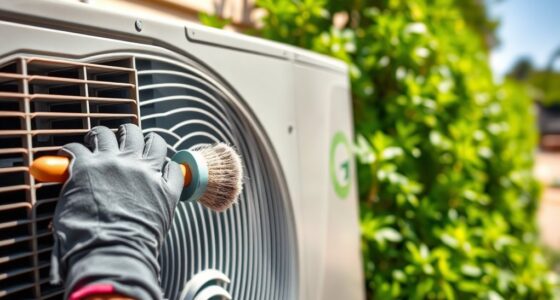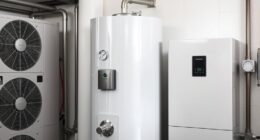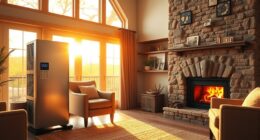To minimize heat pump noise, start by identifying main sources like mechanical parts, airflow, and vibrations through detailed diagnostics, including spectrum analysis. Use targeted strategies such as aerodynamic fan modifications, vibration damping, and custom acoustic barriers made from dense materials. Incorporate sound-absorbing materials and secure mounts to reduce low-frequency hums and tonal sounds. Combining these solutions with careful material selection guarantees effective noise control—continue exploring for more practical tips and innovative techniques to keep your heat pump quiet.
Key Takeaways
- Use targeted frequency analysis to identify and mitigate dominant tonal noise sources from compressors and fans.
- Implement vibration damping and isolation techniques to reduce structure-borne noise transmission.
- Incorporate sound-absorbing materials and innovative barriers designed for low-frequency noise reduction.
- Optimize aerodynamic fan blade design and airflow to minimize broadband and tonal airflow noise.
- Position heat pumps with proper enclosures and vibration mounts to contain and diminish acoustic emissions.
Understanding the Sources of Heat Pump Noise
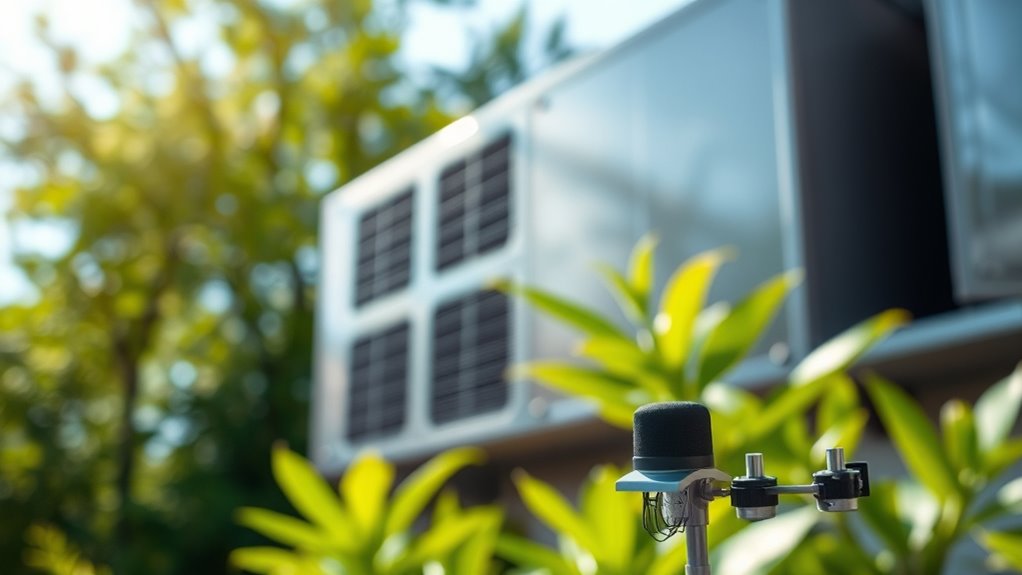
Understanding the sources of heat pump noise is essential for managing and reducing the disturbance they can cause. The main contributors are vibrations from internal mechanical components, airflow noise from fan blades, and mechanical parts like compressors and pumps. Vibrations travel through mounting surfaces and building structures, creating structure-borne noise that can be loud in adjacent spaces. Airflow disturbance over fan blades produces broadband noise and tonal hums, especially at higher speeds. Additionally, electromagnetic excitation and unbalanced fans can generate distinct tonal sounds, adding to overall noise levels. Low-frequency hums at specific frequencies, like 70Hz or 93Hz, are common and particularly bothersome. Proper vibration damping techniques can significantly reduce the transmission of mechanical vibrations, contributing to quieter operation. By understanding these sources, you can better target noise reduction strategies for a quieter, more comfortable environment.
The Limitations of Traditional Noise Control Methods

Traditional noise control methods often fall short when dealing with low-frequency sounds from heat pumps. Large barriers and enclosures can be expensive and impractical, especially since sound attenuation relies on their size relative to the wavelength. Plus, focusing only on broadband noise levels overlooks the tonal frequencies that most impact perceived noise issues. Additionally, targeted solutions that address specific sound frequencies are often more effective in reducing noise impact without extensive infrastructure. Recognizing the importance of contrast ratio in image quality can guide the development of more efficient noise mitigation techniques that better address the unique challenges of low-frequency sounds. Moreover, understanding how resources and tools can optimize noise reduction strategies allows for more precise and cost-effective solutions. Incorporating advanced acoustic modeling can further improve the accuracy of these strategies by simulating how sound waves interact with various mitigation measures. Employing innovative materials designed specifically for low-frequency absorption offers promising avenues for more effective noise control.
Ineffectiveness at Low Frequencies
Conventional noise control methods often fall short when it comes to low-frequency sounds like the hums from heat pumps. These low-frequency noises are tough to manage because standard soundproofing and noise reduction techniques mainly target higher frequencies. Large barriers or enclosures are needed to block low-frequency soundwaves, but they’re often impractical and costly. Additionally, typical noise specifications focus on broadband levels and overlook the tonal content, which is vital for low-frequency noise. As a result, these sounds transmit through structures and reflections, making them hard to attenuate with traditional methods. Best airless paint sprayers utilize high pressure and versatile application techniques that can be more effective in reducing noise transmission in certain scenarios. – Large size requirements limit effectiveness – Standard materials don’t target tonal hums – Transmission through structures reduces noise reduction efficiency – Frequency-specific noise mitigation techniques are increasingly being explored to address these challenges.
Costly and Large Barriers
Effective noise barriers for low-frequency sounds must be large—roughly equal to the wavelength of the sound they aim to block—which makes them impractical for many heat pump installations. These barriers require significant space and material, leading to high costs and logistical challenges. Not only are they expensive to build, but they can also reduce efficiency by obstructing airflow, which diminishes heat pump performance. Large barriers are also difficult to integrate into existing setups, increasing installation complexity. Conventional methods often fail to deliver adequate noise reduction for tonal low-frequency sounds, as their size makes them unmanageable. Additionally, the need for authentic natural materials in noise barriers is often overlooked, which can compromise both aesthetics and effectiveness. Consequently, relying solely on traditional barriers becomes a costly, inefficient approach, forcing you to seek alternative solutions that balance noise control with operational performance and practical installation constraints.
Overemphasis on Broadband Noise
Many noise control strategies focus on reducing overall broadband noise levels, often measured in dB(A), but this approach can be misleading when addressing low-frequency sounds from heat pumps. Broadband noise reduction methods like barriers or silencers often require impractically large sizes, roughly matching the sound’s wavelength, making them ineffective for real-world applications. These solutions also overlook the importance of tonal frequencies, which can dominate noise perception despite low broadband levels. Relying solely on broadband noise metrics can lead you to underestimate disruptive low-frequency hums, such as 112Hz, that cause significant annoyance. To improve noise mitigation, you need targeted, frequency-specific diagnostics that address tonal content rather than just overall broadband noise. This approach ensures you control the dominant low-frequency noise more effectively. Additionally, understanding the principles of acoustic engineering can help develop more precise and effective noise control solutions tailored to specific sound characteristics.
Diagnostic Techniques for Accurate Noise Identification

Accurate noise identification relies on targeted diagnostic techniques that pinpoint specific tonal components and their transmission paths. Frequency analysis is essential, especially when using smartphone apps to detect dominant tones like 70Hz hums or 93Hz compressor sounds. Conducting noise diagnostics by recording at the source, nearby, and inside adjacent structures helps reveal reflections, standing waves, and transmission routes. This detailed approach allows you to match frequency components with heat pump parts, such as fans or compressors, for precise sound source identification. Most standard noise reports overlook these tonal details, leading to ineffective fixes. By focusing on specific frequency characteristics, you can accurately diagnose noise issues, enabling targeted interventions that considerably reduce unwanted sound and improve heat pump performance. Incorporating Kia Tuning techniques can further optimize the system for quieter operation and better efficiency. Recognizing the role of automation in diagnostic processes can streamline troubleshooting and ensure more accurate results. Additionally, understanding sound propagation principles can help in designing effective noise mitigation strategies. Leveraging industry insights can also provide innovative solutions tailored to complex noise challenges. Furthermore, applying tuning principles from Honda Tuning can fine-tune system components for optimal acoustic performance, ensuring quieter operation across various heat pump models.
Practical Strategies for Noise Reduction at the Source
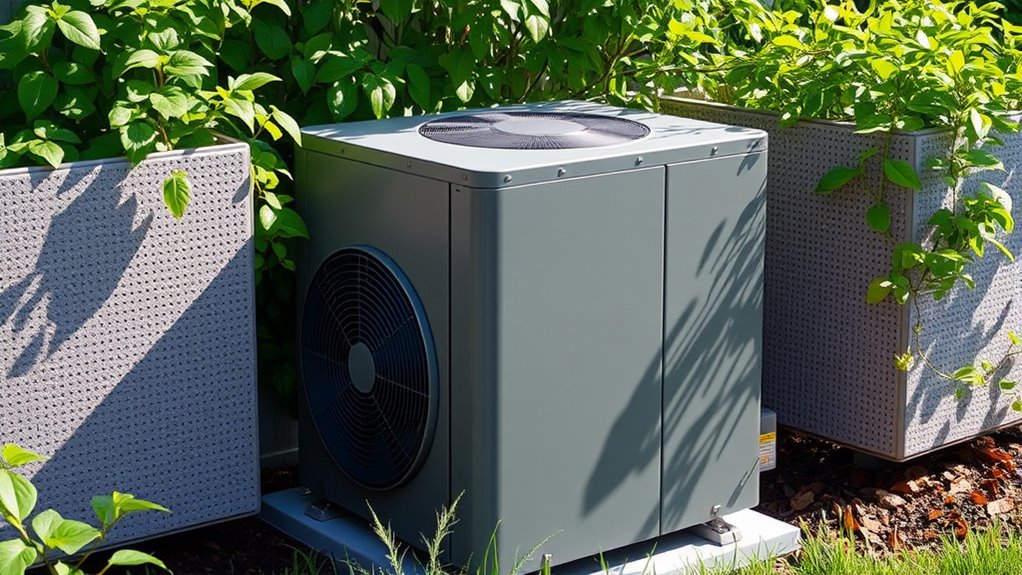
Addressing noise at the source involves implementing practical modifications that directly target the components generating unwanted sound. To reduce fan noise, consider aerodynamic modifications to fan blades, which can cut low-frequency hum caused by airflow disturbance by up to 90%. Vibration damping and isolation techniques applied to compressors and pumps can lower structure-borne noise by about 15dB without affecting efficiency. Using simple spectrum analysis tools helps identify dominant tonal noise frequencies, allowing targeted mitigation. Incorporating noise-reducing materials into the design can further enhance attenuation of sound transmission. Additionally, understanding the acoustic properties of different components can guide more effective noise control strategies. Evaluating the spectrum analysis results can help optimize the placement of damping materials for maximum noise reduction. Applying these strategies in conjunction with vibration isolation can significantly improve overall acoustic performance.
Innovative Acoustic Barriers and Enclosures

Innovative acoustic barriers and enclosures leverage advanced materials and precise engineering to substantially reduce heat pump noise without adding bulk. These barriers incorporate sound-absorbing materials and damping layers that target specific low-frequency tonal noise, achieving up to 90% noise reduction. Built with materials like mass-loaded vinyl and sound-absorbing composites, they contain noise while maintaining airflow and system efficiency. Proper placement—close to the noise source—disrupts standing waves and diminishes reflected sound waves, maximizing effectiveness. Custom-designed enclosures based on detailed noise diagnostics enable targeted attenuation of dominant tonal frequencies without compromising performance. Additionally, understanding headphone connectivity options can be useful for monitoring or personal audio adjustments in noisy environments. Incorporating chia seeds in a diet has been linked to several health benefits, demonstrating how innovative solutions can improve overall well-being. Furthermore, advancements in acoustic materials can enhance the effectiveness of these barriers by providing better sound absorption and durability. The development of soundproofing techniques continues to evolve, offering even more efficient ways to mitigate unwanted noise. Given the ongoing development of AI in cybersecurity and other sectors, integrating smart monitoring systems into acoustic enclosures could further optimize noise mitigation efforts.
Implementing Cost-Effective Vibration Damping Solutions
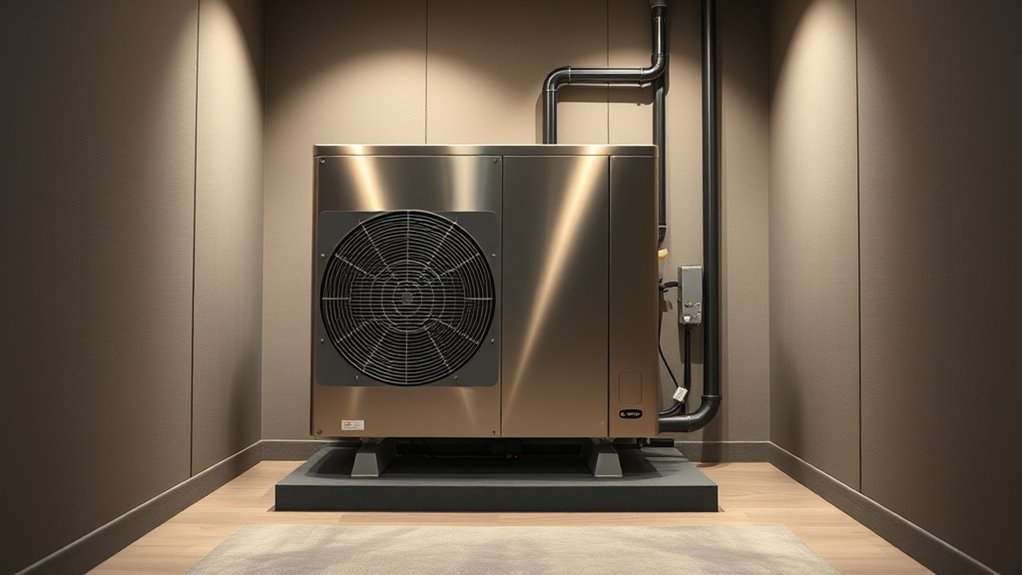
You can reduce heat pump noise efficiently by using simple vibration isolation techniques, such as rubber pads or foam mounts, which cost less and are easy to install. Properly securing compressor mounts and supports helps prevent vibrations from spreading into surrounding structures. Combining these methods with targeted aerodynamic tweaks can lead to significant noise reductions without breaking the bank. Additionally, implementing eco-friendly practices like choosing energy-efficient components can further minimize environmental impact while maintaining quiet operation. Incorporating vibration damping materials can also enhance vibration absorption, leading to even quieter operation and improved longevity of the system. According to Security Zone Info, proper mounting and material choices are crucial in preventing vibrations from transmitting and amplifying noise.
Vibration Isolation Techniques
Implementing cost-effective vibration damping solutions is essential for reducing noise and structural vibrations in heat pump systems. Effective isolation techniques can prevent vibrations from transferring into the building, markedly improving noise reduction. You can use simple methods like mounting heat pumps on rubber pads or resilient mounts to absorb vibrations at their source. Applying vibration damping materials such as rubber mounts, constrained-layer damping, or viscoelastic compounds to compressors and pump supports enhances noise performance without sacrificing efficiency. Using vibration isolation pads beneath pipes and equipment helps break the transmission of mechanical vibrations, reducing rattling and thumping sounds. Remember, small adjustments like wrapping pipes with acoustic damping materials or installing damping pads can make a notable difference in minimizing noise and improving overall acoustic comfort. Incorporating personal development techniques such as mindfulness and goal setting can also help maintain consistent focus on noise reduction strategies and continuous improvement.
Cost-Effective Damping Methods
Cost-effective vibration damping methods offer practical solutions to minimize noise in heat pump systems without increasing expenses substantially. By applying low-cost materials like mass-loaded vinyl or acoustic foam directly on components, you can achieve noise reduction of up to 15dB without sacrificing efficiency. Simple measures such as mounting compressors with rubber isolation pads or resilient mounts substantially diminish vibration transfer to surrounding structures at minimal cost. Wrapping pipes and pump housings with soundproofing materials like Vibra Block® or Quiet Barrier® MD effectively absorbs vibrations and reduces transmitted noise. Installing acoustic damping pads or resilient clips during setup prevents vibrations from amplifying and radiating as noise. Regular maintenance, including tightening fittings and replacing worn mounts, also plays a crucial role in maintaining low vibration and noise levels cost-effectively.
The Role of Material Selection and Construction in Noise Mitigation
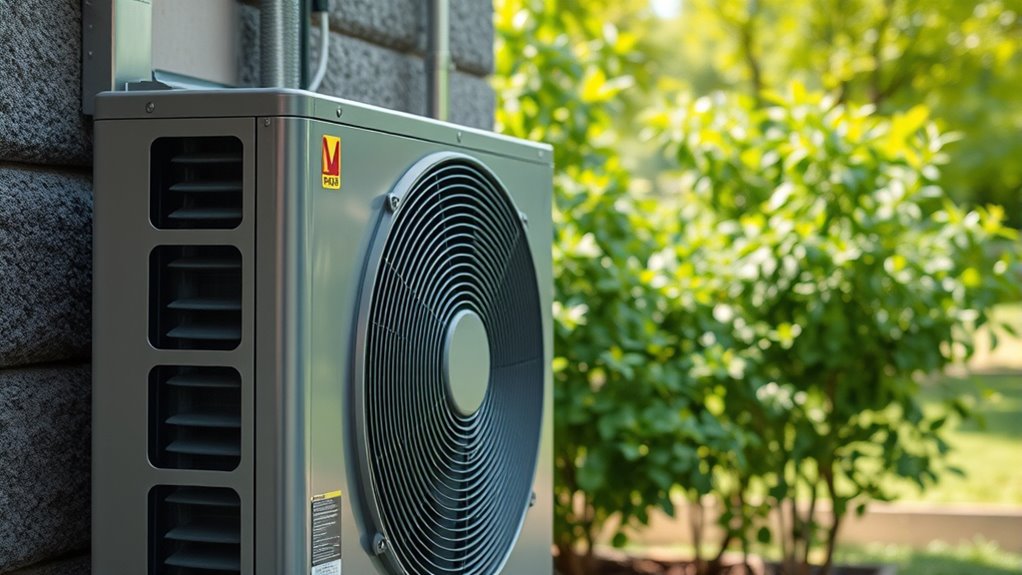
Material selection and construction techniques play a crucial role in effectively reducing noise from heat pumps. By choosing dense, mass-loaded materials like concrete or specialized acoustic panels, you can markedly block and absorb low-frequency vibrations, improving noise mitigation. Incorporating vibration damping compounds such as viscoelastic layers or rubber mounts minimizes structure-borne noise by isolating vibrations at their source. Additionally, using sound-absorptive materials like acoustic foam or mineral wool inside enclosures prevents reflected sound waves from amplifying noise. Proper material selection involves choosing high-damping materials like Quiet Barrier® MD or Reapor panels, which are tailored for acoustic performance.
- Use dense, mass-loaded materials to absorb vibrations
- Incorporate vibration damping compounds for vibration isolation
- Add sound-absorptive layers inside enclosures for reflection reduction
Case Studies Demonstrating Effective Noise Minimization
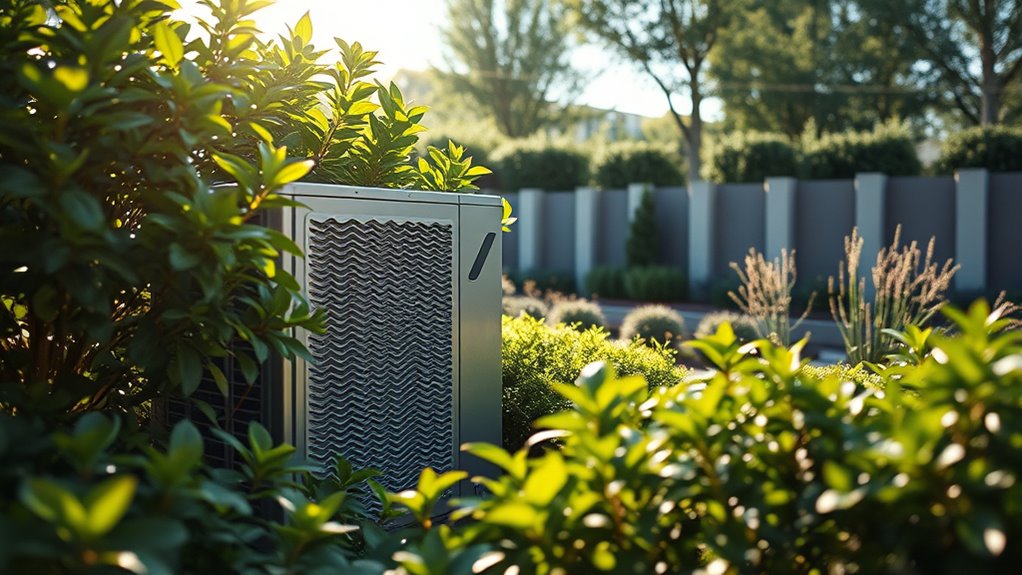
Real-world applications show how targeted modifications can dramatically cut heat pump noise. In one case, an OEM air-source heat pump achieved a 97% reduction (15dB) in fan tonal noise and a 90% (10dB(A)) overall noise decrease through aerodynamic improvements and vibration damping. Diagnostic analysis with smartphone spectrum analysis pinpointed fan, mains hum, compressor, and air noise as key sources, enabling precise, cost-effective noise reduction strategies. Simple DIY solutions like plywood barriers and loft insulation effectively broke standing wave resonances, reducing low-frequency noise by about 30dB nearby. Aerodynamic modifications to fan blades cut pressure fluctuations by up to 90%, decreasing low-frequency hum and boosting efficiency by 23%. Combining damping, aerodynamic tweaks, and acoustic absorbents delivers significant noise reduction without sacrificing heat pump performance.
Frequently Asked Questions
How to Reduce Noise From a Heat Pump?
To reduce noise from your heat pump, start by inspecting and sealing any loose panels or vents. Consider installing sound-absorbing materials like acoustic panels or barriers nearby to block noise. You can also use vibration damping pads under the unit to minimize structure-borne sounds. Additionally, using a smartphone spectrum analyzer helps identify dominant frequencies, allowing targeted mitigation. Simple DIY fixes like plywood enclosures or insulation can profoundly cut noise levels, making your environment more peaceful.
Do Heat Pump Covers Reduce Noise?
You might think a cover will quiet your heat pump, but it’s not that simple. Dense materials can dampen high-frequency noise but often struggle with low-frequency hums, like 93Hz. A poorly designed cover could trap heat and moisture, harming performance. For real noise reduction, customized enclosures with sound-absorbing materials work better, targeting specific frequencies rather than just covering the unit.
How Do You Soundproof an Air Source Heat Pump?
You can soundproof your air source heat pump by building a custom enclosure with sound-absorbing materials like acoustic panels and mass-loaded vinyl. Install vibration dampers or isolators beneath the unit to cut down vibrations. Erect external acoustic barriers or fences with soundproof panels to contain noise. Additionally, make aerodynamic modifications to the fan blades and airflow pathways to greatly reduce low-frequency hums, ensuring quieter operation near your home.
How Do You Dampen Noise From HVAC?
Think of your HVAC system as a drum, and noise as the beat you want to quiet. To dampen it, start with vibration isolators and damping pads under units, preventing vibrations from traveling. Add acoustic barriers or enclosures made of sound-absorbing materials, and consider aerodynamic fan modifications to cut airflow noise. Combining these strategies helps you effectively tame HVAC noise while keeping your system running smoothly.
Conclusion
Now that you understand the key sources of heat pump noise and the innovative solutions available, imagine what’s next. Could the latest materials and designs revolutionize quiet operation? As technology advances, the possibilities for minimizing noise become even more exciting. Stay tuned—your next quiet, efficient heat pump might be closer than you think. Don’t miss out on the breakthroughs that could transform your comfort and peace of mind forever.





